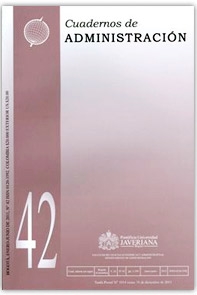Resumen
Este artículo analiza un duopolio diferenciado en el que cada empresa puede utilizar dos herramientas estratégicas para competir con su rival: contratos gerenciales y contratos de precios o cantidades. Utilizando teoría de juegos no cooperativos, en equilibrio se encuentra que: i) cuando las empresas no contratan gerentes, con bienes sustitutos (complementarios), los contratos de cantidades (precios) son una estrategia dominante; ii) cuando las empresas contratan gerentes, para bienes sustitutos y complementarios los contratos de precios son una estrategia dominante; iii) cuando las empresas pueden elegir si contratan gerentes, con bienes sustitutos una de las empresas contrata gerente y elige cantidades y la otra no lo contrata y elige cantidades o precios; con bienes complementarios ambas contratan gerente y eligen precios. iv). El mayor nivel de bienestar social se logra cuando las empresas eligen contratos de precios y no contratan gerentes. Sin embargo, el bienestar social asociado a todos los resultados de equilibrio, es inferior.
Bertrand, J. (1883). Theorie Mathematique de la Richesse Sociale. Journal des Savantes, 67.
Cheng, L. (1985). Comparing Bertrand and Cournot Equilibria: A Geometric Approach. The RAND Journal of Economics, 16 (1), 146-152.
Coase, R. (1937). The nature of the firm. Economica New Series, 4, (16), 386-405.
Cournot, A. (1897). Recherches sur les Principes Mathematiques de la Theorie des Richesses. Paris : Hachette [1838]. N. T. Bacon (trad.), Economic Classics, Macmillan.
Eichberger, J. (1952). Game Theory for Economists. San Diego: Academic Press.
Fershtman, C. (1985). Internal organizations and managerial incentives as strategic variables in competitive environment. International Journal of Industrial Organization, 3, 245-253.
Fershtman, C. and Judd, K. (1987). Equilibrium incentives in oligopoly. American Economic Review, December, 77 (5), 927-940.
Friedman, J. W. (1977). Oligopoly and the Theory of Games. Amsterdam: North Holland.
Jensen, M. C. and Meckling, W. H. (1976). Theory of the firm: Managerial behavior, agency costs and ownership structure. Journal of Financial Economics, 3, 305-360.
Nicholson, W. (2004). Teoría microeconómica, 8a. ed. Madrid: Editorial Thompson.
Singh, N. and Vives, X. (1984). Price and quantity competition in a differentiated duopoly. The Rand Journal of Economics, 15 (4), 546-554.
Ross, S. (1973). The economic theory of agency: The principal's problem. American Economic Review, 63, 134-139.
Sklivas, S. (1987). The strategic choice of managerial incentives. The Rand Journal of Economics, 18 (3), 452-458.
Torres, S. y Mejía, A. (2006). Una visión contemporánea del concepto de administración: revisión del contexto colombiano. Cuadernos de Administración, 19 (32), 111-133.
Vives, X. (1984). Duopoly information equilibrium: Cournot and Bertrand. Journal of Economic Theory, 34, 71-94.
von Stackelberg, H. (1934). Marktform und Gleichgewicht. Vienna: Springer-Verlag.
Williamson, O. (1991). Comparative economic organization: The analysis of discrete structural alternatives. Administrative Science Quarterly, 36, 269-296.
Cuadernos de Administración se encuentra registrada bajo la licencia Creative Commons Reconocimiento 4.0 Internacional. Por lo tanto, esta obra se puede reproducir, distribuir y comunicar públicamente en formato digital, siempre que se reconozca el nombre de los autores y a la Pontificia Universidad Javeriana. Se permite citar, adaptar, transformar, autoarchivar, republicar y crear a partir del material, para cualquier finalidad (incluso comercial), siempre que se reconozca adecuadamente la autoría, se proporcione un enlace a la obra original y se indique si se han realizado cambios. La Pontificia Universidad Javeriana no retiene los derechos sobre las obras publicadas y los contenidos son responsabilidad exclusiva de los autores, quienes conservan sus derechos morales, intelectuales, de privacidad y publicidad.
El aval sobre la intervención de la obra (revisión, corrección de estilo, traducción, diagramación) y su posterior divulgación se otorga mediante una licencia de uso y no a través de una cesión de derechos, lo que representa que la revista y la Pontificia Universidad Javeriana se eximen de cualquier responsabilidad que se pueda derivar de una mala práctica ética por parte de los autores. En consecuencia de la protección brindada por la licencia de uso, la revista no se encuentra en la obligación de publicar retractaciones o modificar la información ya publicada, a no ser que la errata surja del proceso de gestión editorial. La publicación de contenidos en esta revista no representa regalías para los contribuyentes.


